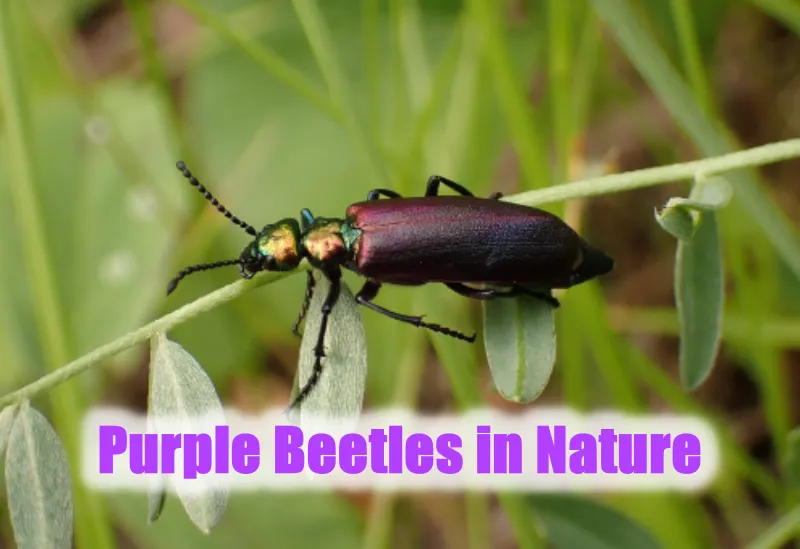On our planet, animals and humans live together. Like we are of different breeds and genetics, animals also have different species. Today we are going to explore the world of the animal kingdom.
The animal whose different species we are going to discover is the beetle, which is purple in color. These purple beetles colors may be affected by their surroundings and their host plants.
Most commonly, these beetles are found in central and northern America, Europe, Asia, and North Africa.
So here is the list:
25 Purple Beetles in Nature
1. Nuttall’s Blister Beetle
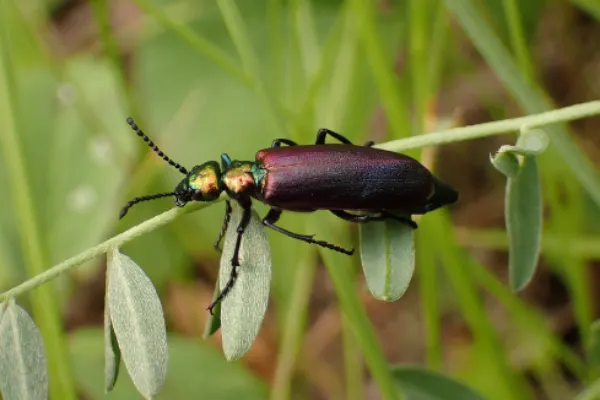
| Scientific name | Lytta nuttallii |
| Size | 15-22 mm |
| Geographical Location | Canada and the United States |
| Identification | purple-green iridescent sheen on the body |
Lytta nuttalli, also known as Nuttall’s blister beetle, is a North American beetle with a brilliant purple and green iridescent exoskeleton. This unique insect, found in Canada and the United States, is known for its ability to synthesize an irritating chemical called cantharidin.
Adult beetles in this family feed on solitary bees in the Apidae family, and as adults, they feed in groups on green plants, particularly legumes. This behavior can pose problems for farmers when they feed on crops like soybeans, sweet clover, and alfalfa.
Although not considered a serious agricultural pest, their populations are naturally limited by their need for native ground-nesting bees as larvae.
2. Notched-Mouth Ground Beetle
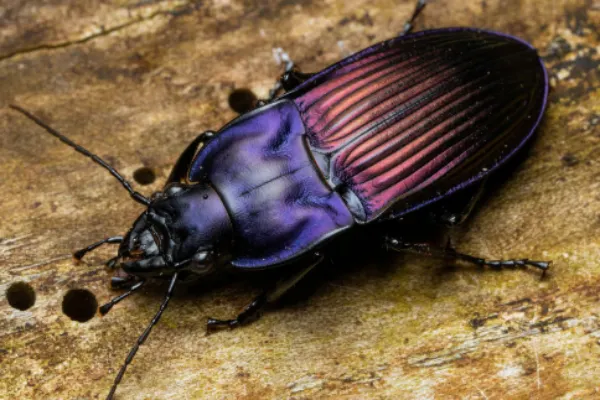
| Scientific name | Dicaelus purpuratus |
| Size | 20-25 mm |
| Geographical Location | U.S., Canada, and Mexico |
| Identification | long legs and a shiny wing cover |
The notched ground beetle is a unique insect found in the Rocky Mountains. Its color can change from purple to blue or red depending on the light angle.
This nocturnal hunter eats snails with its large jaws, making it difficult to miss. The beetle’s jaws are well-suited for finding soft parts of its meal.
Its large, all-black, and semi-glossy appearance makes it a unique insect in nature. Found along sandy trails in degraded shortgrass prairie, it is difficult to miss.
3. Purple Tiger Beetle
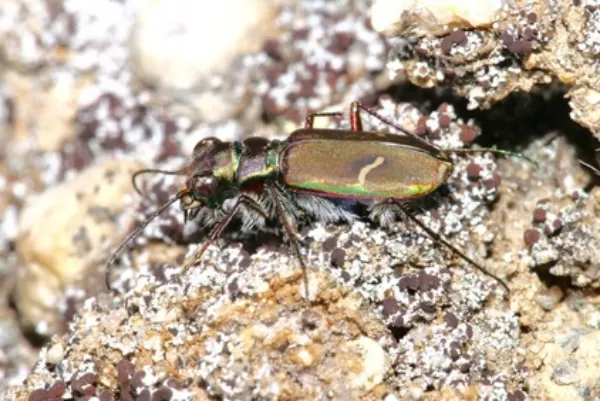
| Scientific name | Cicindela purpurea |
| Size | 12-16 mm |
| Geographical Location | North, East, and South America |
| Identification | round eyes and slender legs |
Tiger beetles, also known as the purple tiger beetle or cow-path tiger beetle, These purple beetles are known for their distinctive patterns and metallic hues. These beetles came in colors ranging from red to purple-brown, with green shades.
These beetles have long, slender legs and dramatic, round eyes, which aid in catching prey. The male beetle is purple with some green prints. The female is green with yellow prints. This beetle is usually seen on trails and paths.
4. Brassy Willow Beetle
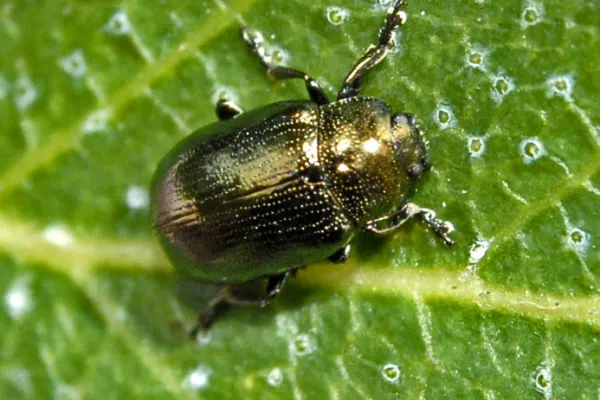
| Scientific name | Phratora vitellinae |
| Size | 3.8-5.0 mm |
| Geographical Location | Arctic regions |
| Identification | metallic purple shade |
Phratora vitellinae beetles are small, metallic bronze, coppery, or bluish beetles with punctured elytra and shoulder bulges.
They have a flat forehead, antennae that do not reach the body, and antennae that are shorter than the females. Adults typically show metallic blue, green, or bronze colors, with copper or purple colors at high elevations or in Arctic regions.
Females have a wide, smooth, sclerotized plate running parallel to the abdomen. Larvae feed in groups in the early instars (molts).
5. Aspen Skeletonizer
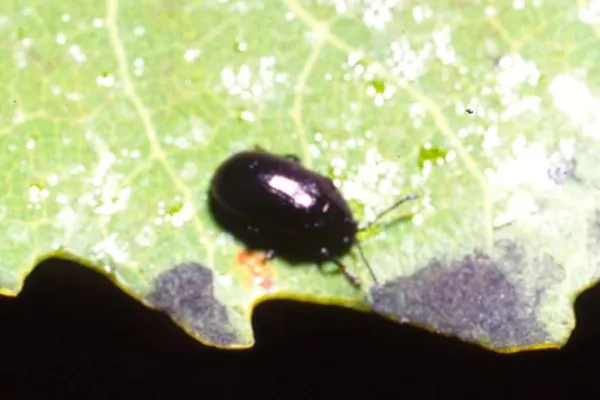
| Scientific name | Phratora purpurea |
| Size | 5-6 mm |
| Geographical Location | North America |
| Identification | full purple-colored body |
The Aspen Skeletonizer has a body covered in purple. The head, body, and legs of this beetle are purple. The aspen skeletonizer is a leaf beetle found in North America, including Maryland, New York, Ontario, British Columbia, and the Northwest Territories.
It feeds on willows and poplars and is deep purple or coppery red in color. Adults emerge in the spring, mating and laying eggs in mid-June, disappearing as eggs and larvae appear. Talking about the other color, some people have noticed that this skeletonizer can be seen in copper too.
6. Carolina Metallic Tiger Beetle
| Scientific name | Megacephala carolina |
| Size | 5-10 mm |
| Geographical Location | Eastern and Southeastern US territories, Canada, and Mexico |
| Identification | emerald-green body |
The Carolina tiger beetle is a vibrant and colorful insect. Because of its vibrant body and vivid colors, it is famous among the people. Their shiny, emerald-green bodies, gem-like appearance, and reddish-copper gleam on the dorsal side make them beautiful.
However, human collecting and habitat destruction have led to a decrease in Carolina tiger beetle numbers and dispersion. This beetle consumes insects that humans consider nuisances, such as spittlebugs, flies, caterpillars, spiders, and ants.
7. Spintherophyta Violaceipennis
| Scientific name | Spintherophyta violaceipennis |
| Size | 3.0-3.8 mm |
| Geographical Location | United States, Mexico |
| Identification | dark blue pronotum |
Spintherophyta violaceipennis is a unique leaf beetle native to North America. Known for its dark blue pronotum and coppery red to deep purple elytra.
This glossy, ladybird-like insect feeds on oak, willow, juniper, and pine, with its name derived from the Latin for “violet wings. The species’ unique color and appearance make it a valuable addition to any natural habitat.
8. Rosemary Beetle
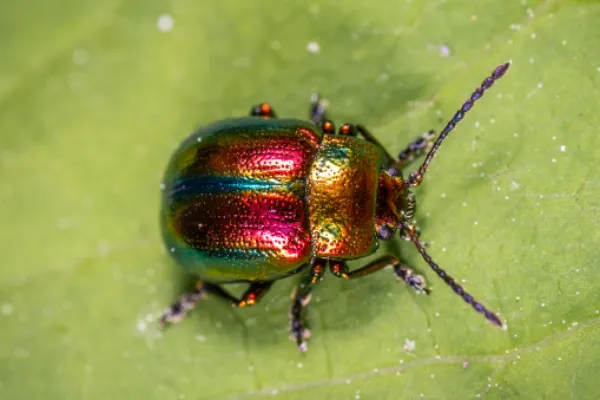
| Scientific name | Chrysolina americana |
| Size | 6-7 mm |
| Geographical Location | Europe and North America |
| Identification | brightly colored elytra and purple stripes |
Chrysolina americana has brightly colored elytra and purple stripes. These beetles eat plants and green vegetation, and they have small wings that allow them to fly for short distances.
Females lay eggs on host plants’ leaves in late summer, and their larvae have pale to blackish streaks. Their unique appearance and color make them a valuable addition to nature.
9. Japanese Earth-Boring Dung Beetle
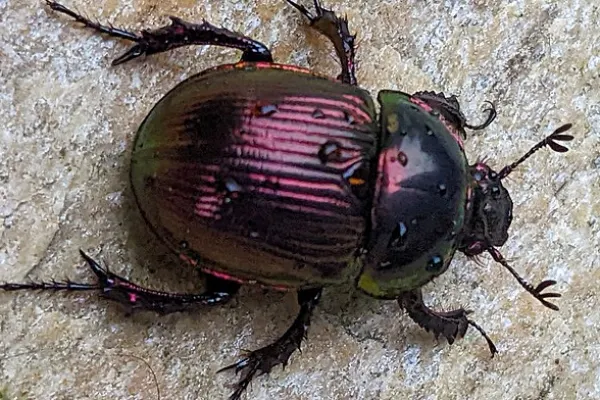
| Scientific name | Phelotrupes auratus |
| Size | 21 mm |
| Geographical Location | Japan, China, and other regions of Asia |
| Identification | metallic-tone sheens |
Phelotrupes auratus, a Japanese earth-boring dung beetle, is a unique insect with black legs and a purple prothorax. Its round body and black legs make it a useful plant for humans.
These beetles consume more than their weight in 24 hours and are brightly colored, with metallic sheens ranging from golden-green to violet-purple.
Found in eastern China, North and South Korea, and Japan, their unique appearance makes them a valuable addition to nature.
10. Pseudaplemonus Limonii
Sun, sea and…weevils! Go to the seaside and find August's weevil of the month; Pseudaplemonus limonii #WOTM pic.twitter.com/nGeeZ9Uhb7
— WeevilRS (@WeevilRS) August 18, 2016
| Scientific name | Pseudaplemonus Limonii |
| Size | 3-4 mm |
| Geographical Location | Europe and Africa |
| Identification | striped body and significant gaps |
A small beetle with an elongated snout and purple body features deep grooves. This beetle is found on Mediterranean lavender.
Pseudaplemonus limonii has metallic purple or copper tones and violet or blue tones. Their sparsely striped bodies and significant gaps distinguish them from other insects in nature. It has tiny white hairs on the body.
11. Green Dock Beetle

| Scientific name | Gastrophysa viridula |
| Size | 4-7 mm |
| Geographical Location | North America and Europe |
| Identification | enlarged abdomen |
The green dock beetle has a length of 4 mm for males and 7 mm for females. Its wings are metallic green with varying colors, and its legs are strong and serrated. The species has enlarged abdomens during mating season.
12. Flower long-horn beetle
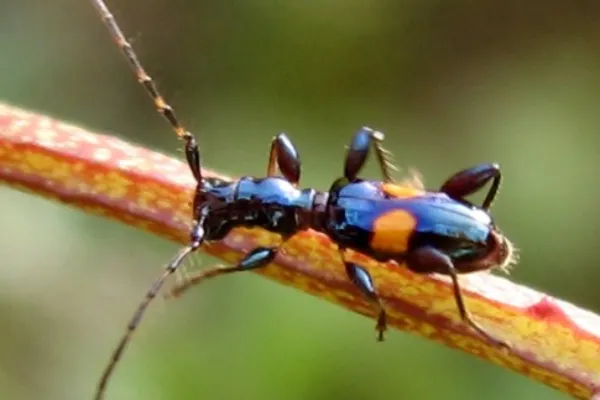
| Scientific name | Zorion Guttigerum |
| Size | 3.78–6.36 mm |
| Geographical Location | New Zealand |
| Identification | small antennae |
Zorion guttigerum beetles are strikingly colorful beetles in New Zealand. The antennae are generally shorter than their bodies. These are diurnal beetles that are good flyers and often fly between flower clusters.
They mate and feed on various plant species, with males often exhibiting aggressive behavior. This beetle mats between October and March, and the body color of the beetle plays a significant role in mating success. Females leave the flowers to lay eggs, while males remain on the flowers.
13. Common Claybank Tiger Beetle
| Scientific name | Cicindela limbalis |
| Size | 12-16 mm |
| Geographical Location | North America |
| Identification | purple body, metallic green sides, and black legs |
Common claybank tiger beetles are endangered in most states. They have a purple body, metallic green sides, and black legs. These beetles can survive for up to a few years and are mostly visible on bare soil nets.
The beetle measures 12–16 mm in length. The back of the beetle is reddish purple, but it can also be boring green or brown. Found on steep, damp, bare clay soil. The beetle has a three-year lifespan. North America is home to the common clay bank tiger beetle.
14. Chrysochares Asiaticus
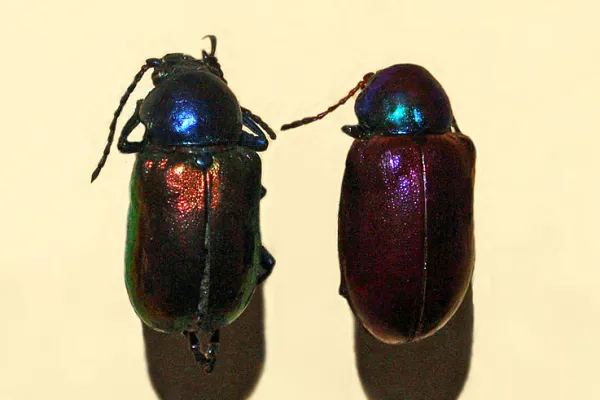
| Scientific name | Chrysochares asiaticus |
| Size | 15–17 mm |
| Geographical Location | Europe and central Russia |
| Identification | elytra of purple, red, or blue-green |
The color of this species depends on their gender. Most females have more purple coloring. The females can be identified by long purple antennae. Chrysochares asiaticus can grow up to 15–17 mm. The pronotum of the beetle is green or greenish-blue.
The elytra are purple, red, or blue with a green gloss. Found in Europe and central Russia. The tip of the antenna is black. The wings cover of the beetle are purple. They have a shiny body. Their color and appearance make them unique insects in nature.
15. Steel-Blue Grapevine Flea Beetle
| Scientific name | Altica torquata |
| Size | 4-5 mm |
| Geographical Location | Central America, North America, and Oceania |
| Identification | dark steel blue with a purple tone |
Steel-blue Grapevine Flea beetles are leaf-eating beetles of the Chrysomelidae family. The beetle has purple antennae and metallic green nuances resembling grapevines.
This beetle is also known as the grape flea beetle. Altica torquata can grow up to 4 to 5 mm. The beetle is dark steel blue in color. These are the shining purple beetles.
They mostly consume grape buds in the early spring and grape leaves in the summer. It seems that they got the name grape flee beetle because of this.
They had long hind legs that helped them jump high. Flea beetles are significant pests of cultivated plants, with adults feeding on the leaves and larvae feeding on the roots.
16. Giant Purple Scarab Beetle
| Scientific name | Megaphanaeus lancifer |
| Size | 28–56 mm |
| Geographical Location | South Africa |
| Identification | horn on the head |
Megaphanaeus lancifer is a big species of beetle in the Scarabaeidae family. They eat carrion, but many species also eat waste. The horn on the head of this beetle is the same size in males and females.
It is normally a dark metallic bluish purple; however, it can also be metallic green on rare occasions. The beetle is one of the biggest beetles in the world. Their color and appearance make them unique insects in nature.
17. True darkling beetle
| Scientific name | Chalcopteroides sp. |
| Size | 12-15 mm |
| Geographical Location | Australia |
| Identification | shiny, colorful abdomen |
The Chalcopterus beetle is a member of the darkling beetle family. This family of beetles is medium in size, about 12–15 mm. They are completely black with an iridescent shine.
Their antennae are medium in length, their bodies are bulky, and their legs are relatively long. The head, which is held vertically against the body, is a distinguishing trait of the genus. This gives them a wonderful, smooth look. Their color and appearance make them unique insects in nature.
18. Warty leaf beetle
| Scientific name | Neochlamisus sp. |
| Size | 3-4 mm |
| Geographical Location | North America |
| Identification | crappy purple wing cover |
Neochlamisus leaf beetles, also known as warty leaf beetles, are cryptic, resembling caterpillar frass. They hatch under a fecal blanket provided by their mother, and larvae use their waste to develop a case.
This practice helps them avoid predators, as their casing resembles caterpillar frass. Most warty leaf beetle species are host plant-specific, primarily using a small group of related plants or a single species for feeding and living.
19. Purple Fungus Beetle
| Scientific name | Gibbifer californicus |
| Size | 25-30 mm |
| Geographical Location | Kansas, Arizona, and New Mexico |
| Identification | Purple wing cover with black spots |
The pleasing fungus beetle is a distinctive insect with a dark head and colorful wing covers. The head is dark, while the wing covers are usually a shade of blue or purple.
Dark indented spots mark the wing covers and a rectangular black marking runs along the outside edge. Upon death, the beetles’ coloration fades considerably.
20. Golden Metallic Stag Beetle
| Scientific name | Cyclommatus metallifer |
| Size | 26-100 mm |
| Geographical Location | Indonesia |
| Identification | large teeth along their jaws |
Cyclommatus metallifer is a type of stag beetle in the Lucanidae family. C. metallifer males’ ability to move is limited by their huge mandibles. Because their ability to run is limited, they must rely on flight to travel great distances.
This purple beetle is a species with extreme sexual dimorphism, with males being larger and having long mandibles for sexual selection. They have larger head muscles to compensate for their weakened bite force.
Their mandibles are adapted to resist bending and torsion, and they have large teeth along their jaws for better grip. Males range from 26 to 100 millimeters in length, while females are less varied.
Male C. metallifer have a high density of mechanoreceptors on their mandibles, which control the force of their bite, protecting their jaws despite their powerful bite muscles.
21. Rainbow Stag Beetle
| Scientific name | Phalacrognathus muelleri |
| Size | 23-70 mm |
| Geographical Location | Northern Queensland, Australia, and New Guinea |
| Identification | heavy body with long jaws |
Phalacrognathus muelleri is sometimes known as the rainbow stag beetle, king, wonderful, or Mueller’s stag beetle. This is a species of beetle in the Lucanidae family.
Northern Queensland, Australia, and New Guinea are home to this species. Males are larger than females. The male beetle grows 24-70 mm whereas a female grows to 23-46 mm.
It is available in purple, green, black, and blue. This species breeds in moist tropical environments. A female can lay up to 50 eggs, which take 10 to 14 days to hatch. Their color and appearance make them unique insects in nature.
22. Violet ground beetle
| Scientific name | Carabus violaceus |
| Size | 20–30 mm |
| Geographical Location | Europe and Japan |
| Identification | Black with a metallic-purple shine |
Carabus violaceus is sometimes known as the violet ground beetle or rain beetle. Violet ground beetles are black with a metallic-purple shine, particularly around the flattened margins of their fused wing covers.
These purple beetles are black beetles with violet or indigo borders on their smooth, oval elytra and thorax. Adult beetles are around 20–30 mm long. Beetles cannot fly. Their color and appearance make them unique insects in nature.
23. Chlorocala Africana
| Scientific name |
Chlorocala Africana |
| Size | 19-24 mm |
| Geographical Location | Democratic Republic of the Congo, Uganda, Tanzania, Ivory Coast, Ghana, and Togo |
| Identification | big iridescent |
Chlorocala africana can grow to be around 19–24 millimeters long. This is the most common species in the genus Chlorocala.
It has an extended body with iridescent green, red, or purple colors, and this variation has caused many authors to describe numerous subspecies of questionable taxonomic identification.
They are simple to breed, extremely successful, and develop quickly. Their color and appearance make them unique insects in nature.
24. Blowout Tiger Beetle
| Scientific name |
Cicindela lengi |
| Size | 12-15 mm |
| Geographical Location | North America and Canada |
| Identification | purple and white color wing shield |
Another purple beetles species enriching the bioiversity is Blowout Tiger Beetle get the scientific name icindela lengi. this purple beetle can grow at a length of 12-15 mm. talking about its body coloration this species of purple beetles has a matte purple color wing shield with white color together forming a pattern.
Also, the maculations is wide and usually connected with the front maculation. Other than that the underside of abdomen metallic green to blue-green with dense white hairs, thorax green or blue to coppery.
25. Big Sand Tiger Beetle
| Scientific name |
Cicindela formosa |
| Size | 14-21 mm |
| Geographical Location | North America |
| Identification | Ivory white maculations on the elytra |
The Big sand tiger beetle, one of the largest North American species, measures 14-21 mm in length and is the largest tiger beetle in Montana.
Its color varies from dark brown to bright coppery red, purple, greenish red, and rarely bright green. Ivory white maculations on the elytra are variable, and the ventral metallic color varies from dark green to blue or purple.
Conclusion
These are some of the most beautiful purple beetles. Their color wholly depends on nature and their surroundings. Some of them are herbivores, and others are predators. Their beautiful color might amaze you. This shows the creativity of nature itself.
We end it here today, hoping that you like it. Soon we came up with some new facts about animals, insects, and more. Till then, stay tuned. Keep looking for more intellectual knowledge with Howitsee.
FAQs:
Q1: What is the most notable feature of Nuttall’s Blister Beetle?
Ans: Nuttall’s Blister Beetle is known for its brilliant purple and green iridescent exoskeleton, with a distinctive purple-green sheen.
Q2: Where can you find the Notched-Mouth Ground Beetle?
Ans: The Notched-Mouth Ground Beetle is found in the U.S., Canada, and Mexico, particularly in the Rocky Mountains.
Q3: What makes the Purple Tiger Beetle unique?
Ans: The Purple Tiger Beetle, or Cicindela purpurea, is known for its round eyes, slender legs, and distinctive metallic hues ranging from red to purple-brown.
Q4: Where are Brassy Willow Beetles typically found?
Ans: Brassy Willow Beetles, scientifically known as Phratora vitellinae, are found in Arctic regions, exhibiting metallic purple shades.
Q5: What is the geographical distribution of the Aspen Skeletonizer?
Ans: The Aspen Skeletonizer is found in North America, including Maryland, New York, Ontario, British Columbia, and the Northwest Territories.
Q6: Why is the Carolina Metallic Tiger Beetle famous among people?
Ans: The Carolina Metallic Tiger Beetle is famous for its vibrant, emerald-green body and colorful appearance, mainly found in Eastern and Southeastern U.S. territories, Canada, and Mexico.
Q7: What is unique about Spintherophyta Violaceipennis?
Ans: Spintherophyta Violaceipennis is a leaf beetle native to North America, known for its dark blue pronotum and coppery red to deep purple elytra.
Q8: Where can you find the Rosemary Beetle?
Ans: The Rosemary Beetle is found in Europe and North America.
Q9: What distinguishes the Japanese Earth-Boring Dung Beetle?
Ans: The Japanese Earth-Boring Dung Beetle can be distinguished through its metallic-tone sheens.
Q10. What is the significance of Pseudaplemonus Limonii‘s striped body and gaps?
Ans: Pseudaplemonus Limonii, found in Europe and Africa, is a small beetle with metallic purple or copper tones, distinctive stripes, and significant gaps on its body.
Also Read:

As a content writer, I like to write about different niches. I have a curiosity about nature and animals. And like to learn about them. Through my writing, I like to share my experience and knowledge with you. I hope you are enjoying it too.
